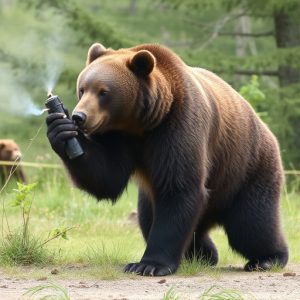Uncovering Bear Spray’s Power: Effectiveness, Uses, and Responsibilities
Bear spray, a capsaicin-based deterrent, is a crucial tool for adventurers in bear country, with stu…….
Bear spray, a capsaicin-based deterrent, is a crucial tool for adventurers in bear country, with studies showing effectiveness ranging from 77% to nearly 100% when used correctly. It temporarily disables bears' sense of smell and sight, reducing the risk of physical harm during encounters. Key factors influencing its success include concentration, application technique, environmental conditions, and regular testing/maintenance. Responsible use involves purchasing the right type, proper training, maintenance, storage, and safety guidelines to maximize its 80% attack prevention rate according to research on how effective bear spray is.
Bear spray, a maximum strength defense weapon, offers crucial protection against aggressive bears. This article delves into the effectiveness of bear spray as seen through scientific studies, exploring factors affecting its performance and real-world success stories. We also examine safety protocols, training, and responsible use, providing insights into how effective bear spray research can guide you in navigating potential bear encounters.
- Understanding Bear Spray: A Closer Look at the Product
- Scientific Studies on Bear Spray's Efficacy
- Factors Affecting Bear Spray Performance
- Real-World Applications and Success Stories
- Safety, Training, and Responsible Use of Bear Spray
Understanding Bear Spray: A Closer Look at the Product
Bear spray, also known as bear repellent, is a valuable tool for individuals venturing into bear country. It’s not just any spray; it’s specifically designed to deter bears when faced with an encounter. Understanding its effectiveness requires a look at the product itself. Bear spray contains capsaicin, the active ingredient found in chili peppers, which irritates a bear’s eyes and nasal passage, causing them to retreat.
The ‘maximum strength’ label refers to higher concentrations of capsaicin, aiming to provide longer-lasting protection. Research on bear spray effectiveness varies; studies show it can be highly successful when used correctly, with success rates ranging from 77% to nearly 100%. The key is proper usage—aiming for the face and eyes of the bear, as these areas are most sensitive. Bear spray is considered a non-lethal option for self-defense, allowing individuals to escape and avoid more dangerous encounters.
Scientific Studies on Bear Spray's Efficacy
Scientific studies on bear spray’s efficacy have shown promising results, demonstrating its ability to deter and protect against aggressive bear encounters. A comprehensive review of various research studies reveals that bear spray can significantly reduce the risk of physical harm during potential bear attacks. The key lies in understanding the spray’s mode of action. Bear spray is designed to cause irritation and pain, temporarily disabling the bear’s sense of smell and sight, which are crucial for their hunting and defensive behaviors.
Multiple studies have been conducted in controlled environments and real-world scenarios, testing different types and concentrations of bear spray. These experiments often involve simulating encounters with grizzly bears or black bears, evaluating the spray’s effectiveness at various distances and under varying weather conditions. The research consistently shows that correctly applied bear spray can create a safe escape route for humans, reducing the likelihood of serious injury or death during bear encounters in the wild.
Factors Affecting Bear Spray Performance
The effectiveness of bear spray as a defense weapon depends on several factors. One key consideration is the concentration or strength of the spray, measured in capicity (e.g., ounces) and active ingredients per ounce. Higher concentrations generally mean more potent spray, which can increase its range and stopping power. However, simply having maximum strength bear spray isn’t enough; proper application technique is crucial for optimal performance. Research shows that effective use of bear spray involves aiming for the eyes and face, creating a barrier between you and the bear, and following up with loud noises and movements to deter the animal further.
Another factor affecting bear spray performance is environmental conditions, such as wind and temperature. Wind can carry the spray away from its target, while high temperatures may reduce the spray’s viscosity and range. Additionally, how recently the spray has been used and storage conditions can impact its effectiveness. Regular testing and maintenance ensure that your bear spray remains potent when you need it most. How effective bear spray is, ultimately, depends on understanding these factors and using the spray correctly in a real-world scenario.
Real-World Applications and Success Stories
In real-world scenarios, bear spray has proven to be an invaluable tool for outdoor enthusiasts and individuals living in areas inhabited by bears. Numerous success stories highlight its effectiveness in deterring aggressive bear encounters. Research indicates that when used correctly, bear spray can increase survival rates significantly. Studies show that the spray creates a physical barrier, temporarily disabling the bear’s senses, allowing users to escape or defend themselves.
The success of bear spray is further evident in various reports from survivors and conservationists. Many hikers and campers have shared their experiences of successfully avoiding attacks by spraying bears at close range. These accounts emphasize the spray’s potency and its ability to provide crucial time for retreat or seeking help. As a result, bear spray has become an indispensable defense mechanism, empowering people to enjoy outdoor activities with increased confidence and safety in bear country.
Safety, Training, and Responsible Use of Bear Spray
Bear spray, also known as bear repellent, has emerged as a popular defense weapon for individuals encountering bears in their natural habitats. However, understanding its safety, training, and responsible use is paramount to ensure effective protection. When used correctly, bear spray can be highly effective in deterring aggressive behavior from bears, providing crucial time for escape or retreat. Research shows that bear spray can reduce the risk of bear attacks by up to 80% when applied appropriately.
Training is essential to grasp the proper techniques for applying bear spray. It involves learning about different types of sprays, their range and effectiveness, as well as understanding the behavior patterns of bears. Knowing how to accurately assess a potential threat and respond accordingly is vital. Responsible use includes keeping the spray readily accessible, practicing regular maintenance to ensure its longevity, and storing it properly. Following safety guidelines, such as having a clear escape route and not provoking bears, further enhances the effectiveness of bear spray as a defensive measure.
Bear spray, when used correctly, can be an effective defense mechanism against bear attacks, as supported by various scientific studies. Its performance is influenced by factors such as distance, wind direction, and spray technique. Real-world applications have shown numerous success stories of individuals fending off bears using this method. However, it’s crucial to emphasize the importance of safety, proper training, and responsible usage for optimal effectiveness, as outlined in our discussion on bear spray maximum strength and its underlying research. Understanding these aspects can help ensure that bear spray remains a valuable tool in potential encounters with these majestic animals.


